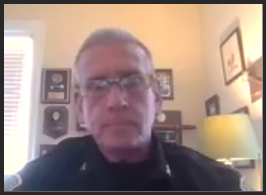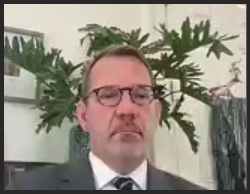
President Jim Ryan during virtual Town Hall
by James A. Bacon
The University of Virginia called in the Virginia State Police to disperse “UVA Encampment for Gaza” protesters because they feared the demonstration was spiraling out of control, said President Jim Ryan, University Police Chief Tim Longo, and other University leaders in a virtual town hall early this afternoon.
Some protesters had tried to smuggle in wooden structures that could be used as barricades to fortify the encampment, as seen at pro-Palestinian demonstrations at other universities. Although that effort was thwarted, law enforcement authorities learned that four individuals associated with previous Charlottesville events “that resulted in violence” had entered the so-called liberation zone. Meanwhile, organizers were using social media to appeal to more outsiders to join them, and the numbers were growing.
Ryan said he acted before more outsiders joined, the encampment became more entrenched, and the potential for violence increased. “If we didn’t act, would we be faced with 50 tents and 20 outsiders?” he said. “Where would we be then?”
Ryan, Longo, and Provost Ian Baucom stated repeatedly that protesters spurned repeated efforts to engage in dialogue. The limited communications that did occur were relayed through faculty members. University officials were at pains to contrast the anarchist protest with other pro-Palestinian demonstrations organized by student groups, in compliance with university guidelines.
UVA leadership also addressed criticisms raised by critics and local media in the aftermath of the action that resulted in a total of 27 arrests (up from 24 in earlier reports), including 12 students, four employees, three former students or employees, and eight individuals not affiliated with UVA.
An ad hoc anarchist group billing itself on Instagram as UVA Encampment for Gaza set up tents Tuesday near the UVA Chapel, similar to pro-Palestinian encampments and liberation zones at other universities. Unlike other pro-Palestinian rallies at UVA, this one took the president and provost by surprise. Baucom described how he and Ryan first learned of the demonstration when they were presenting some faculty awards at the Rotunda and happened to look out the window. “There was no pre-notice,” he said.

Police Chief Tim Longo
Longo responded immediately. The university police chief told the protesters to take down the tents, which violated multiple university rules, but said they could maintain their around-the-clock vigil as long as they followed the rules.
Relations with the administration were testy, however. Many protesters, who included students, grad students, and members of the community, wore masks that concealed their faces. As is standard for anarchist groups, participants were discouraged from speaking to the media, and outsiders were warned not to take photographs. Likewise, the group refused to talk to administrative officials, relaying messages through faculty members they trusted.
By Thursday the protest showed signs of petering out, but on Friday the protesters set up tents in defiance of University orders, called for reinforcements from the community, and issued a set of demands — divestment of UVA endowment assets of companies doing business in Israel, cutting off relations with Israeli universities, and a promise of no punishment for participants in the protest — with a noon deadline the following day. The University countered with a letter politely refusing the first two demands but offering to engage in dialogue. The Encampment responded by publishing the letter on Instagram with “Bullshit” scrawled over it in large red letters.
The excuse for setting up the tents was that it had begun raining. The University suggested the demonstrators go home for the evening and return in the morning, when they would be free to resume the tent-free protest, according to Ryan. The protesters refused. Instead, the group issued calls for more people to join the protest and bring supplies.
While the encampment remained peaceful up until the weekend, University police saw troubling signs. According to Longo, three or four young people brought in wood materials hidden under a tarp that could be used to build barriers like those seen elsewhere to “fortify and defend” the encampment. The police persuaded the protesters to remove the wood. More worrisome on Friday, information from “law enforcement assets” revealed that four black-clad individuals had moved into the encampment. Longo referred to them obliquely as “persons known to have been associated with historic events that resulted in violence.” Black is the preferred color of Antifa “antifascist” radicals, some of whom had participated in counter-demonstrations against white supremacists in 2017.
Due to the presence of families and children Friday night, however, Longo said, the police “stood down.”
The chief returned the next morning to tell protesters to take the tents down voluntarily. After 45 minutes of fruitless palaver with faculty liaisons, he then announced that the university’s facility management would remove the tents and store them for safekeeping; the demonstrators would be free to remain in place. But when staff moved in to dismantle the tents, protesters gathered around them and blocked their way. Longo found the situation threatening. “They said they had a duty to fight for their cause. Their actions and words forced me to conclude that voluntary compliance was not going to occur.”
The next step was to set up a perimeter around the encampment to prevent outsiders from swelling the number of protesters. Longo then ordered the anarchists to disperse. The order was met by defiance. Protesters locked arms. Officers were met with umbrellas wielded in an aggressive manner. Said Longo: “My fear was that active resistance would continue to escalate, and that the need for police force would escalate.”
As the showdown dragged on Saturday morning, hundreds of onlookers — many of them friendly to the protesters — gathered to watch the unfolding drama.
 Ryan, Baucom, Chief Operating Officer J.J. Davis, Dean of Student Affairs Kenyon Bonner, and representatives of different law enforcement groups were huddling in a command post at an undesignated location. They followed events on a live video feed. Sensitive to accusations that he was nowhere to be seen during the confrontation, Ryan told the Town Hall viewers that he thought that his presence at the demonstration would “inflame the situation rather than de-escalate it.” Baucom explained that he thought his place was with the university president. “There was a lot of information flowing in. It was a fluid situation.”
Ryan, Baucom, Chief Operating Officer J.J. Davis, Dean of Student Affairs Kenyon Bonner, and representatives of different law enforcement groups were huddling in a command post at an undesignated location. They followed events on a live video feed. Sensitive to accusations that he was nowhere to be seen during the confrontation, Ryan told the Town Hall viewers that he thought that his presence at the demonstration would “inflame the situation rather than de-escalate it.” Baucom explained that he thought his place was with the university president. “There was a lot of information flowing in. It was a fluid situation.”
To Ryan, the principles at stake were very clear. Encampment for Gaza had a right to free speech and assembly. But there are “time, place and manner” restrictions on the exercise of both rights. University policy has some 18 rules regarding the erection of tents on the Grounds. Many are related to safety and the environment. Tents cannot be raised close to buildings or underneath trees. Permits were required, and the demonstrators didn’t have one. “The rules were being violated,” Ryan said. More to the point, he added, “the protesters knew they weren’t allowed and wanted to keep them up anyway.”
Ryan said he made the call to order the police to remove the tents. “Demonstrators were given multiple opportunities to comply. They refused to do so,” he said. Because University police were not trained in or equipped for crowd-control tactics, the Virginia State Police were called in. “These were very hard calls, excruciatingly hard,” he said.
Longo gave the demonstrators seven distinct orders to disperse. They refused. Then police formed a phalanx with their shields and advanced on the encampment. Although some people resisted, the camp was quickly cleared. At one point, police deployed pepper spray — not tear gas — to disperse the crowd. Protesters were treated for the irritant by medical personnel on the scene. No one suffered significant injuries. Twenty-seven individuals were arrested.
“I’ve been president for six years,” Ryan concluded in the virtual town hall. “I’m fully and painfully aware that we lost some of our trust Saturday.” But decisions had to be made. Sometimes decisions will leave some people unhappy. “Once you make a decision you have to own it, and you face the personal and professional consequences.”
James A. Bacon is contributing editor to The Jefferson Council. This article has been republished with permission from the Jefferson Council blog.


